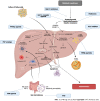Non-alcoholic fatty liver disease: Immunological mechanisms and current treatments
- PMID: 37701135
- PMCID: PMC10494768
- DOI: 10.3748/wjg.v29.i32.4831
Non-alcoholic fatty liver disease: Immunological mechanisms and current treatments
Abstract
Non-alcoholic fatty liver disease (NAFLD) causes significant global disease burden and is a leading cause of mortality. NAFLD induces a myriad of aberrant changes in hepatocytes at both the cellular and molecular level. Although the disease spectrum of NAFLD is widely recognised, the precise triggers for disease progression are still to be fully elucidated. Furthermore, the propagation to cirrhosis is poorly understood. Whilst some progress in terms of treatment options have been explored, an incomplete understanding of the hepatic cellular and molecular alterations limits their clinical utility. We have therefore reviewed some of the key pathways responsible for the pathogenesis of NAFLD such as innate and adaptative immunity, lipotoxicity and fibrogenesis, and highlighted current trials and treatment options for NAFLD patients.
Keywords: Fat; Immune system; Inflammation; Liver; Mitochondria.
©The Author(s) 2023. Published by Baishideng Publishing Group Inc. All rights reserved.
Conflict of interest statement
Conflict-of-interest statement: Authors declare no conflict of interests for this article.
Figures




Similar articles
-
Alcoholic liver disease: Current insights into cellular mechanisms.World J Biol Chem. 2021 Sep 27;12(5):87-103. doi: 10.4331/wjbc.v12.i5.87. World J Biol Chem. 2021. PMID: 34630912 Free PMC article. Review.
-
Understanding lipotoxicity in NAFLD pathogenesis: is CD36 a key driver?Cell Death Dis. 2020 Sep 25;11(9):802. doi: 10.1038/s41419-020-03003-w. Cell Death Dis. 2020. PMID: 32978374 Free PMC article. Review.
-
Proteomic and genomic studies of non-alcoholic fatty liver disease--clues in the pathogenesis.World J Gastroenterol. 2014 Jul 14;20(26):8325-40. doi: 10.3748/wjg.v20.i26.8325. World J Gastroenterol. 2014. PMID: 25024592 Free PMC article. Review.
-
From Non-Alcoholic Fatty Liver to Hepatocellular Carcinoma: A Story of (Mal)Adapted Mitochondria.Biology (Basel). 2023 Apr 14;12(4):595. doi: 10.3390/biology12040595. Biology (Basel). 2023. PMID: 37106795 Free PMC article. Review.
-
Hepatocyte and immune cell crosstalk in non-alcoholic fatty liver disease.Expert Rev Gastroenterol Hepatol. 2021 Jul;15(7):783-796. doi: 10.1080/17474124.2021.1887730. Epub 2021 Feb 18. Expert Rev Gastroenterol Hepatol. 2021. PMID: 33557653 Review.
Cited by
-
Ketosis Suppression and Ageing (KetoSAge): The Effects of Suppressing Ketosis in Long Term Keto-Adapted Non-Athletic Females.Int J Mol Sci. 2023 Oct 26;24(21):15621. doi: 10.3390/ijms242115621. Int J Mol Sci. 2023. PMID: 37958602 Free PMC article.
-
Investigating peripheral blood monocyte and T-cell subsets as non-invasive biomarkers for asymptomatic hepatic steatosis: results from the Multi-Ethnic Study of Atherosclerosis.Front Immunol. 2024 Mar 26;15:1243526. doi: 10.3389/fimmu.2024.1243526. eCollection 2024. Front Immunol. 2024. PMID: 38596669 Free PMC article.
-
Immunomodulation in non-alcoholic fatty liver disease: exploring mechanisms and applications.Front Immunol. 2024 Jan 30;15:1336493. doi: 10.3389/fimmu.2024.1336493. eCollection 2024. Front Immunol. 2024. PMID: 38352880 Free PMC article. Review.
-
Unveiling the mitophagy puzzle in non-alcoholic fatty liver disease (NAFLD): Six hub genes for early diagnosis and immune modulatory roles.Heliyon. 2024 Mar 31;10(7):e28935. doi: 10.1016/j.heliyon.2024.e28935. eCollection 2024 Apr 15. Heliyon. 2024. PMID: 38601640 Free PMC article.
-
Lymph Node Adiposity and Metabolic Dysfunction-Associated Steatotic Liver Disease.Biomedicines. 2025 Jan 1;13(1):80. doi: 10.3390/biomedicines13010080. Biomedicines. 2025. PMID: 39857664 Free PMC article.
References
-
- Sayiner M, Koenig A, Henry L, Younossi ZM. Epidemiology of Nonalcoholic Fatty Liver Disease and Nonalcoholic Steatohepatitis in the United States and the Rest of the World. Clin Liver Dis. 2016;20:205–214. - PubMed
-
- Alexander M, Loomis AK, Fairburn-Beech J, van der Lei J, Duarte-Salles T, Prieto-Alhambra D, Ansell D, Pasqua A, Lapi F, Rijnbeek P, Mosseveld M, Avillach P, Egger P, Kendrick S, Waterworth DM, Sattar N, Alazawi W. Real-world data reveal a diagnostic gap in non-alcoholic fatty liver disease. BMC Med. 2018;16:130. - PMC - PubMed
Publication types
MeSH terms
LinkOut - more resources
Full Text Sources
Medical

